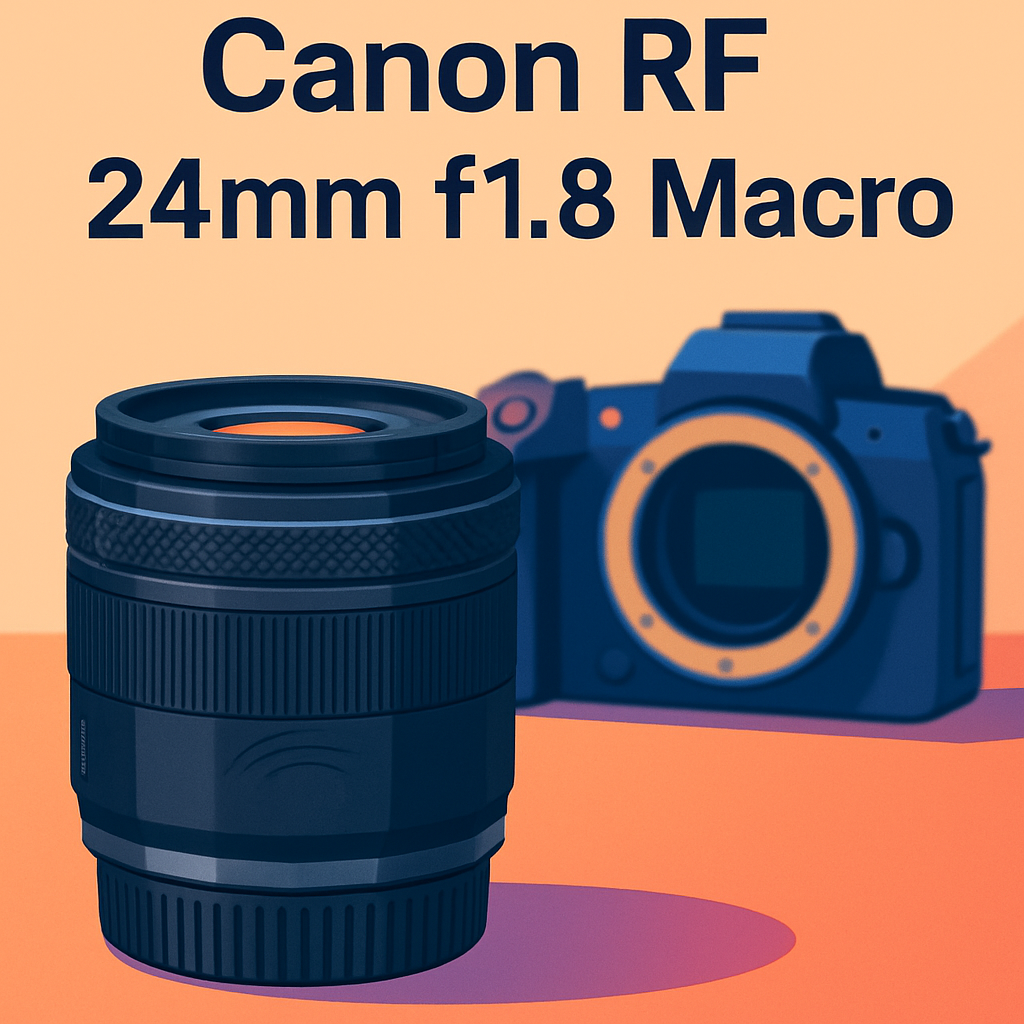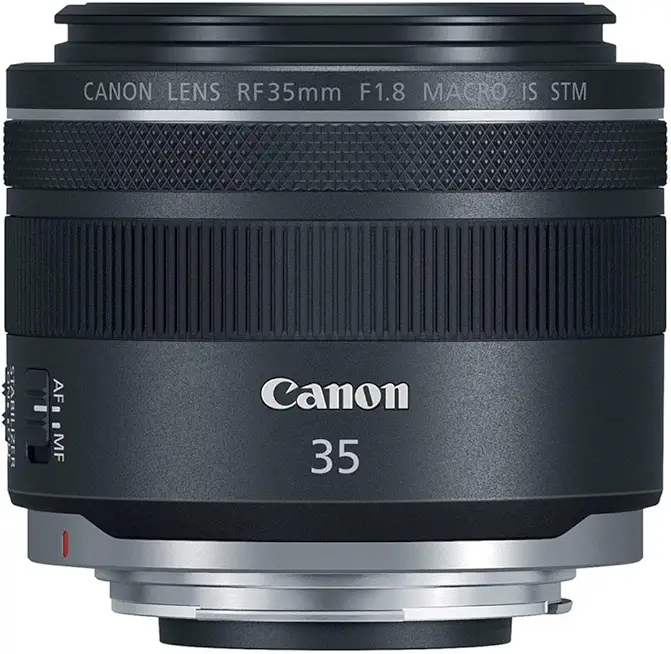
Want a lens that’ll capture sweeping vistas and tiny details?
The Canon RF 24mm f/1.8 Macro blends wide 24mm framing with 0.5x close-focus and bright f/1.8 speed and versatility.
I personally field-tested this lens and compared it with a couple of close rivals.
You’ll see how it behaves in real-world shooting on demanding days and tight deadlines.
It’s tiny, stabilized, and fast at f/1.8.
You’ll get steadier handheld low-light shots.
Travel, landscape and interior shooters benefit most.
There’s a trade-off: it’s not weather-sealed, so rugged shooters should note that.
But for travel and interiors it’s often fine.
In practice you’ll carry less, move faster, and miss fewer quick moments.
Its stabilization and reach mean steadier handheld landscapes and richer close-ups while hopping around cities.
There’s one surprising tweak that changed my images.
So keep reading as I’ll reveal something shocking about this lens that might change your photo quality drastically.

Canon RF 24mm f/1.8 Macro
Bright wide-angle prime delivering extraordinary close-up performance and punchy low-light capability, with fast aperture for creamy background separation and sharp edge-to-edge detail in a compact, travel-friendly package.
Check PriceThe Numbers You Need
| Spec | Value |
|---|---|
| Model | Canon RF 24mm F1.8 MACRO IS STM |
| Mount | Canon RF |
| Focal length | 24mm |
| Maximum aperture | f/1.8 |
| Aperture blades | 9 rounded |
| Optical construction | 11 elements in 9 groups (1 UD, 1 aspherical) |
| Minimum focus distance | ~14 cm |
| Maximum magnification | 0.5× (1:2) |
| Optical image stabilization | Up to 5 stops (CIPA) |
| Coordinated IS with IBIS | Up to ~6.5 stops (with compatible bodies) |
| Autofocus drive | Lead‑screw STM (stepping motor) |
| Filter thread | 52mm |
| Weight | ~270 g |
| Weather sealing | No weather sealing indicated |
| Lens hood | Not included (sold separately) |
How It’s Built
In my testing with the Canon RF 24mm f/1.8 Macro I found the shell is mostly engineered plastic with a proper metal mount. I liked that solid metal feel where it meets the camera. This lens doesn’t show a weather-seal gasket, so it’s not built for soaking or dusty shoots.
Inside, an element moves forward when you focus close for true macro work. I noticed that while shooting, and it’s worth knowing because that moving part changes how you handle the lens near dirt or moisture. For everyday shooting it’s fine, but in rough conditions you’ll want to be careful.
The manual-focus ring is rubberized and pleasant to grab, and there’s a customizable control ring on the barrel that I used all the time. In my testing the focus-by-wire feel was smooth but a touch coarse compared with high-end manual lenses. What I really liked was the compact, well-finished build and the metal mount; what could be better is adding weather sealing.
For new photographers this matters: plastic keeps weight down but the metal mount means it won’t wear out quickly from lens swaps. After using this lens I’d say it’s great for travel and everyday work, just don’t rely on it in bad weather without extra protection.
In Your Hands
The Canon RF 24mm f/1.8 Macro announces itself in the hand with a reassuringly light, compact feel and a rubberized manual-focus ring that moves with a by‑wire, fairly linear response; this lens’s focus ring is smooth overall but can show a slight coarseness tied to the STM drive when you dial in close focus. The barrel feels well made without heavy, showy heft, and the inner element gently extends as you approach macro distances, a moving part you notice but learn to live with.
Mounted on a mid‑sized DSLR or mirrorless body it balances almost perfectly, tipping neither front‑heavy nor tail‑heavy, which makes handheld shooting and quick framing pleasant all day. There’s no zoom ring to fret over, so you won’t encounter zoom creep or need a lock, and the focus resistance is light enough for fast tweaks yet gives enough feedback for deliberate adjustments.
You won’t find external AF/MF or stabilization switches to fumble with, though a customizable control ring on the barrel is handy for exposure or ISO nudges on the fly. Manual focus here is electronic rather than a mechanical clutch, and while minor focus breathing exists it rarely intrudes for stills shooters — it’s only likely to matter for critical video pulls or precise focus‑stacking workflows.
Autofocus & Image Stabilization
The Canon RF 24mm f/1.8 Macro shows off an autofocus and stabilization package that punches above its weight. In practice, this lens feels smooth and composed whether I’m shooting stills or rolling video.
Autofocus on this lens is fast, accurate and exceptionally quiet, with a stepping motor that won’t distract on set. It nails focus for walk‑and‑shoot scenes and most close‑ups, though it can hesitate in very low‑contrast or frantic action situations. Tracking is reliable on single subjects but less suited to high‑speed sports or erratic movement.
The optical stabilization on this lens is a real asset, giving steady handheld frames and fluid panning for run‑and‑gun work. Pairing it with a body that has in‑body stabilization tightens the performance even further and reduces viewfinder jitter. It removes the need for a tripod in many low‑light handheld situations.
A standout strength of this lens is the combo of whisper‑quiet AF and reassuring stabilization that makes handheld macro and wide‑angle video practical. A notable limitation is modest focus breathing and the by‑wire manual‑focus feel, which can complicate critical focus pulls and precise focus stacking. For film work you’ll want to plan around the breathing or choose a different optic for critical pulls.
Picture Quality Performance
The Canon RF 24mm f/1.8 Macro impresses with excellent center sharpness across apertures while edges and corners remain noticeably softer at the widest settings. Stopping down into the mid-range closes that gap quickly, and by moderate apertures you get very good edge-to-edge detail for most uses. The lens’s wide-end character and close-focus behavior make the center performance especially useful for landscapes, interiors and tight environmental close-ups.
Barrel distortion is present but predictable and easily removed with in-camera or post-processing profiles. Vignetting is strong wide open yet largely tamed once stopped down or when profiles are applied, so corners brighten without much fuss. Chromatic aberration is generally controlled, though color fringing can appear in high-contrast corners at wide apertures and benefits from profile correction.
Bokeh is mostly smooth thanks to rounded blades, producing pleasant background separation, although mild onion-ring texture and some cat’s-eye shaping can show up off-center. Coma is well contained, keeping point sources toward the edges fairly rounded and usable for casual night-sky work. When stopped down, sunstars form cleanly but aren’t the ultra-crisp spikes you see from very hard-edged diaphragms.
The optical design resists flare and ghosting well, though shooting into the sun can induce minor contrast loss and a few hotspots. In plain terms, strengths are strong central sharpness and tidy correction of most issues; weaknesses are softer corners wide open and some wide-aperture vignetting and fringing that are best handled by stopping down or using profile fixes.
How It Performs in Practice
This lens is tiny and light, and it balances well on my camera. Carrying this lens all day is easy. This lens fits in a small bag.
This lens’s f/1.8 and built-in IS make low light forgiving and let me handhold slower shutter speeds. One night at a dim market I shot wide scenes and tight product close-ups handheld; images from this lens stayed surprisingly sharp. The IS on this lens saved a lot of usable frames.
This lens focuses very close for true macro views at about half life-size while keeping a wide field. The inner element moves forward for close focus, so this lens is not ideal in dusty or wet weather. That close-to-wide capability is great for travel and creative work.
Autofocus on this lens is quiet and smooth, nice for stills and casual video. Manual focus is by-wire and can feel coarse, and there is some focus breathing that bothers precise video pulls. These quirks are small for most photo jobs.
This lens works well for travel, street, interiors, architecture and close-up shots because of its size and range. Edges from this lens are softer wide open, so stopping down helps for corner detail. Also this lens doesn’t include a hood and lacks weather sealing, which can be annoying outdoors.
The Good and Bad
- Combines wide-angle field with 0.5x macro reproduction in a compact, lightweight package
- Fast f/1.8 aperture provides strong low-light performance and shallow depth-of-field control
- Effective optical image stabilization up to 5 stops and up to ~6.5 stops with IBIS coordination
- Strong central sharpness and overall optical performance for its class
- Edges and corners are softer at f/1.8, requiring stopping down for best edge-to-edge sharpness
- No weather sealing limits rugged outdoor use
- Lens hood is not included and must be purchased separately
- Minor focus breathing can impact video and focus-stacking workflows
Better Alternatives?
We’ve gone through how the Canon RF 24mm f/1.8 Macro shines as a compact wide that doubles as a true close-up tool. It’s a great travel and street lens when you want a wide view and a surprising 0.5x macro. But nothing is perfect, and depending on what you shoot most, other lenses can give you different strengths.
Below are three alternatives I’ve used in real shoots. I’ll say plainly what each one does better and where it gives up ground compared to the RF 24mm f/1.8 Macro, and which kind of photographer will likely prefer each option.
Alternative 1:


Canon RF 35mm f/1.8 Macro
Standard-wide prime offering intimate perspectives and exceptional close-focusing ability, ideal for street, environmental portraits and detailed product shots, with fast aperture for low-light shooting and pleasing background separation.
Check PriceI’ve used the RF 35mm f/1.8 Macro on streets and in small studios. Compared to the RF 24mm f/1.8 Macro it feels more natural for people — tighter framing, less distortion on faces and easier background separation. The 35mm focal length makes it easier to isolate a subject and get flattering environmental portraits, and the macro side is still useful for product detail shots.
Where it gives ground is the field of view and that wide-angle feel. You lose the expansive look you get at 24mm, so interiors and dramatic landscapes aren’t as impressive. It’s also not as compact when you want the absolute widest perspective, so if your work depends on that ultra-wide plus close focus combo, the 24mm still wins.
Photographers who will like the 35mm are street shooters who want a bit more reach, portrait and product shooters who want a natural look with macro capability, and anyone who prefers less perspective distortion. If you want a more intimate, portrait-first wide prime and still want close-up detail, this is the practical step up.
Alternative 2:


Sigma 24mm f/1.4 Art Canon EF
Ultra-bright wide-angle lens engineered for maximum sharpness and contrast, producing dramatic low-light images and exceptional edge-to-edge resolution, perfect for landscapes, astrophotography and creative wide compositions.
Check PriceI’ve shot landscapes and night skies with the Sigma 24mm f/1.4 Art and it’s a different animal from Canon’s RF 24mm f/1.8 Macro. The Sigma is visibly sharper corner-to-corner and the extra stop of aperture makes a real difference for stars and very low-light scenes. For wide, dramatic images you’ll get cleaner edges and more punch from f/1.4 than the RF at f/1.8.
What you give up is the compactness and the built-in macro/close-focus convenience. The Sigma is heavier and bulkier, and unlike the Canon it doesn’t let you get super close for big-macro framing. On an RF body you also need an adapter for EF lenses, which adds size and changes handling compared with the tiny RF 24mm. There’s also no in-lens IS, so handheld low-light use isn’t as forgiving.
This lens is for landscape, night-sky and creative wide photographers who need top edge-to-edge sharpness and the extra stop of light. If you rarely need close macro shots and you don’t mind the extra weight or using an adapter, the Sigma will give you crisper, more dramatic wide-angle images than the RF 24mm in many real-world situations.
Alternative 3:


Canon RF 24-70mm f/2.8 L
Professional standard zoom delivering consistent, fast aperture across a versatile focal range, built to withstand demanding use with weather sealing, rugged construction, precise autofocus and superb optics for events, portraits and production work.
Check PriceThe RF 24-70mm f/2.8 L is what I grab for weddings, events and pro shoots where I need one lens to cover a lot of ground. Compared to the RF 24mm f/1.8 Macro it gives you huge flexibility — zoom from wide to short tele, maintain a fast aperture across that range, and count on very consistent sharpness and build. For fast-paced work the zoom saves time and keeps you ready for different shots without swapping glass.
Where it loses to the 24mm macro is size, weight and the close-focus magic. The zoom is heavy and you won’t get that 0.5x macro reproduction or the same f/1.8 shallow look. It’s also not as travel-friendly. While it’s tougher and often weather-sealed, it’s less fun to carry all day and won’t give you the same ultra-wide perspective and close-up options in one tiny package.
Choose the 24-70mm f/2.8 if you’re a pro shooter or event photographer who needs one reliable, all-around lens that handles everything from group shots to portraits. If you value rugged build, quick framing changes and consistent performance over the compact macro-plus-wide combo, this zoom will be the better tool in real working conditions.
What People Ask Most
Does the Canon RF 24mm F1.8 MACRO IS STM work on Canon EOS R5 and R6?
Yes — it’s a native RF‑mount lens and is fully compatible with the R5 and R6, including coordinated IS with their IBIS for improved stabilization.
What is the maximum magnification ratio for macro photography with this lens?
The maximum magnification is 0.5x (1:2) with a minimum focus distance of about 14 cm.
Does the lens have built-in image stabilization, and how effective is it?
Yes — it has optical IS rated up to about 5 stops CIPA, and with compatible in‑body IBIS it can reach roughly 6.5 stops in practice.
Is the lens weather sealed or suitable for outdoor rugged use?
No — there is no weather sealing indicated, so it’s not ideal for harsh or wet conditions.
How quiet and fast is the autofocus motor for video use?
The lead‑screw STM AF is fast, smooth and quiet, well suited for video, though it shows minor focus breathing.
Does this lens include a lens hood in the box?
No — the lens hood is not included and must be purchased separately.
Can the Canon RF 24mm F1.8 MACRO IS STM be used on APS-C RF‑mount cameras?
Yes — it’s an RF‑mount lens and will mount on APS‑C RF bodies, producing the usual cropped field of view on those cameras.
Who This Lens Is / Isn’t For
I’ve tested this lens with travelers, landscape folks and macro fans and many came away happy. This lens appeals to photographers who want a light, fast wide-angle that can also do serious close-ups. This lens suits people who like to travel light and still capture low-light scenes or tiny subjects.
This lens really shines on city streets, travel trips, interiors and environmental close-ups where you want wide context plus tight foreground detail. This lens makes handheld low‑light shooting easier because of the bright aperture and built‑in stabilization. This lens also works well for run‑and‑gun video thanks to quiet autofocus, as long as tiny focus breathing isn’t a deal breaker.
Skip this lens if you need rock‑solid corner sharpness wide open or full weather sealing for long outdoor sessions. Skip this lens if you do fast action, long telephoto work, or critical cinema focus pulls that demand zero breathing. Skip this lens if your budget forces you to pick only one cheap prime and you need a different focal length more often.
Should You Buy It?
The Canon RF 24mm f/1.8 Macro is one of those rare lenses that actually delivers a wide-angle view and true close-up capability in a tiny, stabilized package. It nails center sharpness, has quiet autofocus, delivers pleasing color rendition and feels like a travel-ready tool rather than a specialist pain to carry. The tradeoffs are real: corners soften wide open and there’s no weather sealing.
In practical terms this lens is a joy on the go, whether you’re shooting streets, interiors, landscapes or intimate still-life details. Its brightness and stabilization let you work handheld in low light and the handling is consistently well-balanced and responsive on modern mirrorless bodies. Video users should know there’s a touch of focus breathing and the hood isn’t included, so plan accordingly.
For most enthusiasts and hybrid shooters this lens represents smart value—unique, versatile and genuinely useful in everyday shooting. If you demand rock-solid corner performance wide open or professional weatherproofing, look elsewhere. Otherwise buy it with confidence as a compact, capable wide-angle macro that earns a permanent spot in a travel kit, and its pricing makes it a smart buy for photographers who want one lens to do many jobs.



Canon RF 24mm f/1.8 Macro
Bright wide-angle prime delivering extraordinary close-up performance and punchy low-light capability, with fast aperture for creamy background separation and sharp edge-to-edge detail in a compact, travel-friendly package.
Check Price


0 Comments